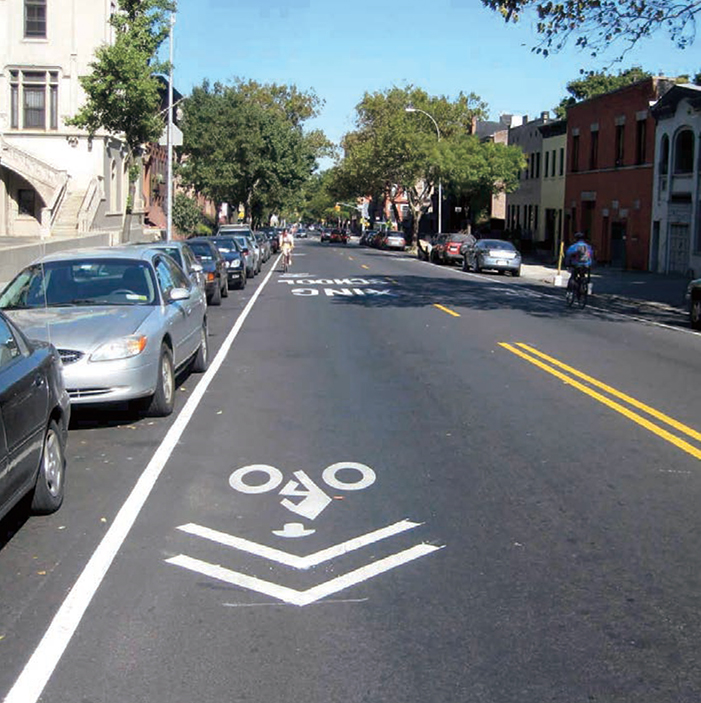
Shared Lane Markings

NEW YORK, NY
Shared Lane Markings (SLMs), or “sharrows,” are road markings used to indicate a shared lane environment for bicycles and automobiles. Among other benefits, shared lane markings reinforce the legitimacy of bicycle traffic on the street, recommend proper bicyclist positioning, and may be configured to offer directional and wayfinding guidance. The shared lane marking is not a facility type, it is a pavement marking with a variety of uses to support a complete bikeway network. The MUTCD outlines guidance for shared lane markings in section 9C.07.
Benefits
Encourages bicyclists to position themselves safely in lanes too narrow for a motor vehicle and a bicycle to comfortably travel side by side within the same traffic lane.103
Alerts motor vehicle drivers to the potential presence of bicyclists.
Alerts road users of the lateral position bicyclists are expected to occupy within the travel lane.
Indicates a proper path for bicyclists through difficult or potentially hazardous situations, such as railroad tracks.
Advertises the presence of bikeway routes to all users.
Provides a wayfinding element along bike routes.
Demonstrated to increase the distance between bicyclists and parked cars, keeping bicyclists out of the “door zone.”104
Encourages safe passing by motorists.105
Requires no additional street space. Reduces the incidence of sidewalk riding.106
Reduces the incidence of wrong-way bicycling.107
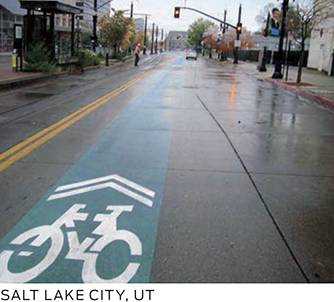
SALT LAKE CITY, UT
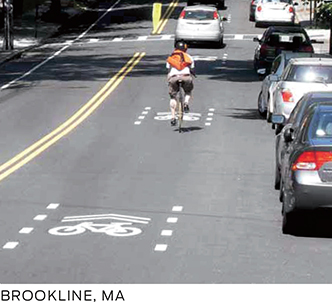
BROOKLINE, MA
Typical Applications
Shared lane markings should not be considered a substitute for bike lanes, cycle tracks, or other separation treatments where these types of facilities are otherwise warranted or space permits. Shared lane markings can be used as a standard element in the development of bicycle boulevards to identify streets as bikeways and to provide wayfinding along the route.
Desirable shared lane marking applications:
To indicate a shared lane situation where the speed differential between bicyclist and motorist travel speeds is very low, such as:
• On bicycle boulevards or similar low volume, traffic calmed, shared streets with a designed speed of < 25 mph.
• On downhill segments, preferably paired with an uphill bike lane. If space permits, consider a wide downhill bike lane.
• On streets where the traffic signals are timed for a bicycling travel speed of 12 to 15 miles per hour.
As a reasonable alternative to a bike lane:
• Where street width can only accommodate a bicycle lane in one direction. On hills, lanes should be provided in the uphill direction.
• Within single or multi-lane roundabouts.108
• Along front-in angled parking, where a bike lane is undesirable.
To strengthen connections in a bikeway network:
• To fill a gap in an otherwise continuous bike path or bike lane, generally for a short distance.
• To transition bicyclists across traffic lanes or from conventional bike lanes or cycle tracks to a shared lane environment.
• To direct bicyclists along circuitous routes.
To clarify bicyclist movement and positioning in challenging environments:
• To designate movement and positioning of bicycles through intersections.
• To designate movement and positioning of bicyclists through a combined bike lane/turn lane.
• To assist bicyclists in taking the lane in the presence of a double turn lanes. Double turn lanes are undesirable for bicyclists.
• In the street alongside separated bikeway facilities such as cycle tracks, to permit continued use of the street by bicyclists who prefer to ride in the street.
• Generally, not appropriate on streets that have a speed limit above 35 mph.109

Optional Shared Lane Marking Applications
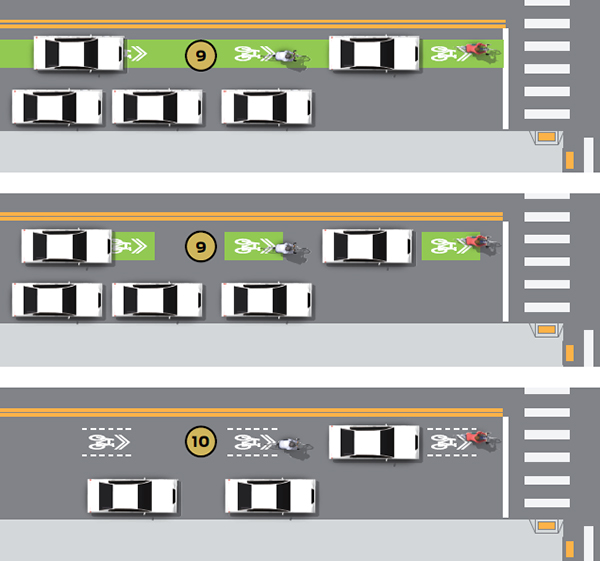
 Modified Shared Lane Markings as seen in Portland, OR
Modified Shared Lane Markings as seen in Portland, OR

Required Features
 The Shared Lane Marking in use within the United States is the bike-and-chevron “sharrow,” illustrated in MUTCD figure 9C-9.
The Shared Lane Marking in use within the United States is the bike-and-chevron “sharrow,” illustrated in MUTCD figure 9C-9.
 Shared Lane Markings shall not be used on shoulders, in designated bicycle lanes, or to designate bicycle detection at signalized intersections. (MUTCD 9C.07 03)
Shared Lane Markings shall not be used on shoulders, in designated bicycle lanes, or to designate bicycle detection at signalized intersections. (MUTCD 9C.07 03)
Recommended Features
 Frequent, visible placement of markings is essential. The number of markings along a street should correspond to the difficulty bicyclists experience taking the proper travel path or position. SLMs used to bridge discontinuous bicycle facilities or along busier streets should be placed more frequently (50 to 100 feet) than along low traffic bicycle routes (up to 250 feet or more). SLMs used along low volume routes can be staggered by direction to provide markings closer together.110
Frequent, visible placement of markings is essential. The number of markings along a street should correspond to the difficulty bicyclists experience taking the proper travel path or position. SLMs used to bridge discontinuous bicycle facilities or along busier streets should be placed more frequently (50 to 100 feet) than along low traffic bicycle routes (up to 250 feet or more). SLMs used along low volume routes can be staggered by direction to provide markings closer together.110
 Lateral placement is critical to encourage riders to avoid the “door zone,” and to encourage safe passing behavior. MUTCD guidance recommends minimum placement when a parking lane is present at 11 feet from the curb face.111
Lateral placement is critical to encourage riders to avoid the “door zone,” and to encourage safe passing behavior. MUTCD guidance recommends minimum placement when a parking lane is present at 11 feet from the curb face.111
 On streets with posted 25 mph speeds or slower, preferred placement is in the center of the travel lane to minimize wear and encourage bicyclists to occupy the full travel lane.
On streets with posted 25 mph speeds or slower, preferred placement is in the center of the travel lane to minimize wear and encourage bicyclists to occupy the full travel lane.
 On streets with posted 35 mph speeds or faster and motor vehicle volumes higher than 3,000 vpd shared lane markings are not a preferred treatment. On these streets other bikeway types are preferred.
On streets with posted 35 mph speeds or faster and motor vehicle volumes higher than 3,000 vpd shared lane markings are not a preferred treatment. On these streets other bikeway types are preferred.
 If on-street vehicle parking is not present, SLMs should be placed far enough from the curb to direct bicyclists away from gutters, seams, and other obstacles. On streets with posted 25 mph speeds or slower, preferred placement is in the center of the travel lane to minimize wear and encourage bicyclists to occupy the full travel lane. MUTCD guidance recommends minimum placement with no parking at 4 feet from the curb face.112
If on-street vehicle parking is not present, SLMs should be placed far enough from the curb to direct bicyclists away from gutters, seams, and other obstacles. On streets with posted 25 mph speeds or slower, preferred placement is in the center of the travel lane to minimize wear and encourage bicyclists to occupy the full travel lane. MUTCD guidance recommends minimum placement with no parking at 4 feet from the curb face.112
Optional Features
 For wayfinding purposes the orientation of the chevron marking may be adjusted to direct bicyclists along discontinuous routes.
For wayfinding purposes the orientation of the chevron marking may be adjusted to direct bicyclists along discontinuous routes.
 Color may be used to enhance the visibility of the shared lane marking and to further encourage desired lane positioning.113
Color may be used to enhance the visibility of the shared lane marking and to further encourage desired lane positioning.113
 Dotted line markings may accompany the shared lane marking to further encourage desired lane positioning.114
Dotted line markings may accompany the shared lane marking to further encourage desired lane positioning.114

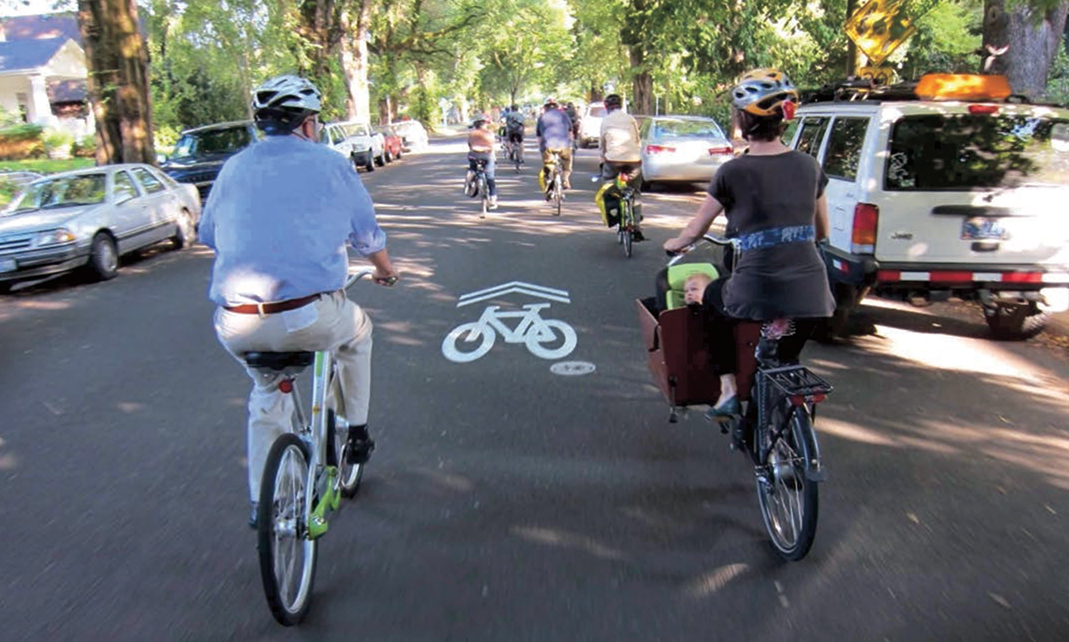
PORTLAND, OR (PHOTO: DAVE ROTH)
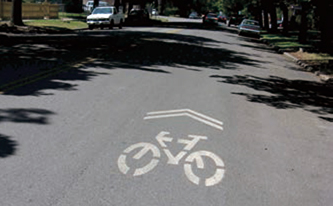
MISSOULA, MT
In an evaluation of a lane-within-a-lane treatment in Salt Lake City, researches found that “Eleven months after implementation, the fraction of in street cyclists riding in the preferred zone, at least 4 ft from the curb, had risen from 17% to 92%.”
Furth, P., Dulaski, D. M., Bergenthal, D., Brown, S. (2011). More Than Sharrows: Lane-Within-A-Lane Bicycle Priority Treatments in Three U.S. Cities. Presented at the 2011 Annual Meeting of the Transportation Research Board.
Maintenance
Frequent, visible placement of markings is essential.
Lateral placement is critical to encourage riders to avoid the “door zone.”
The shared lane marking may be placed in the center of the lane between wheel treads to minimize wear.
Treatment Adoption and Professional Consensus
Used by at least 76 jurisdictions in 26 States, including most NACTO member cities.
Benefits
Familiarizes users with the bicycle network.
Identifies the best routes to destinations.
Overcomes a “barrier to entry” for infrequent bicyclists.
Signage that includes mileage and travel time to destinations may help minimize the tendency to overestimate the amount of time it takes to travel by bicycle.
Visually indicates to motorists that they are driving along a bicycle route and should use caution.
Passively markets the bicycle network by providing unique and consistent imagery throughout the jurisdiction.
Typical Applications
Along all streets and/or bicycle facility types that are part of the bicycle network.
Along corridors with circuitous bikeway facility routes to guide bicyclists to their intended destination.